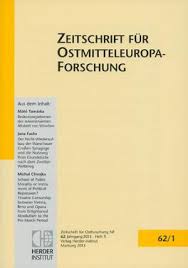Der Holocaust in der litauischen Historiographie seit 1991
The Holocaust in Lithuanian historiography since 1991
Author(s): Klaus RichterSubject(s): WW II and following years (1940 - 1949), Transformation Period (1990 - 2010), History of the Holocaust, Post-Communist Transformation, History of Antisemitism
Published by: Verlag Herder-Institut
Keywords: Holocaust; Lithuanian historiography; since 1991;
Summary/Abstract: In the course of the research on the Holocaust as a European phenomenon, the example of Lithuania has received considerable attention as regards the aspect of perpetratorship. The article traces the Lithuanian historiographical debate on the events of the summer of 1941, when Soviet Lithuania was occupied by German troops, thus initiating the killing of Lithuanian Jews. The article focusses on three historical institutions, which bore a distinctively positive connotation when Lithuania regained its independence: the 'Lithuanian Activist Front' (LAF), the 'June Uprising' and the 'Provisional Government'. Initially embedded in a narrative of Lithuanian resistance against foreign occupation, historians since 1991 have noted the close association of all three institutions with the events of the Holocaust. The LAF was proven to have been dominated by radical and antisemitic nationalists. Its publications are judged by some to have exercised a decisive influence on Lithuanian antiJewish mood on the eve of the German occupation. The 'June Uprising' was found to have brought violence and oppression on a large scale upon Lithuania's Jews. The same is true for the 'Provisional Government', which has been proven not only to have taken no measures to prevent pogroms, but in fact to have passed antisemitic laws. In the second half of the 1990s the establishment of important research institutions investigating the Holocaust correlates chronologically with the refution of the widespread myth of the 'Jewish communist', thus initiating a change of perspective away from the Lithuanian victims towards the Lithuanian perpetrators. This change has also facilitated the introduction of the term 'Holocaust', where before the term 'genocide' was used to denote the killing of Jews during the German occupation as well as the oppression of Lithuanians under the yoke of Stalinism, thus establishing a causal and qualitative relation between both. It is especially the confutation of such historical constructs of victims and perpetrators that confronts the Lithuanian historiography with deep mistrust within parts of the Lithuanian population. When put into an Eastern European context, this proves to be not a singularly Lithuanian case, but rather a phenomenon of postcommunist historiography.
Journal: Zeitschrift für Ostmitteleuropa-Forschung
- Issue Year: 56/2007
- Issue No: 3
- Page Range: 389-416
- Page Count: 28
- Language: German

